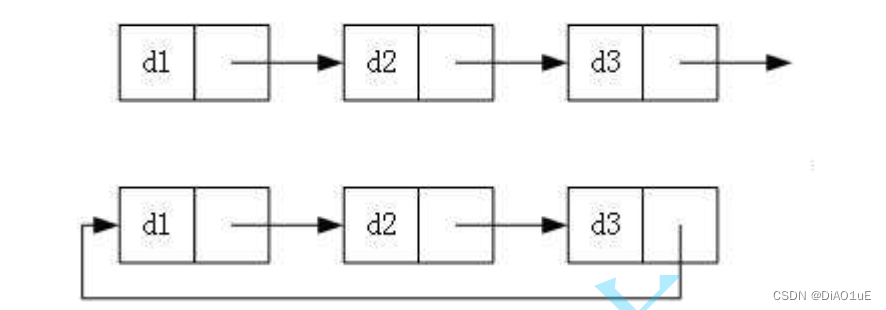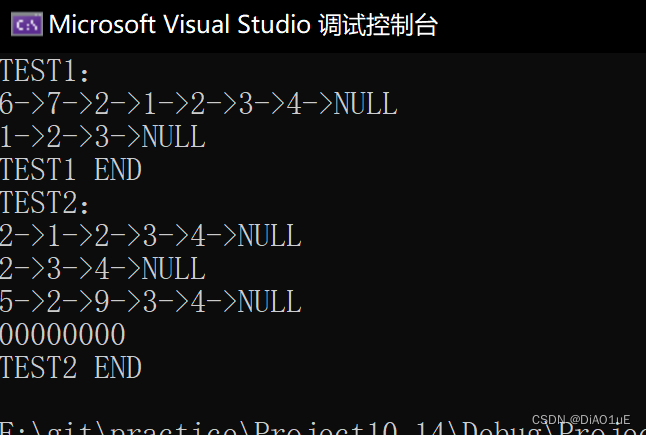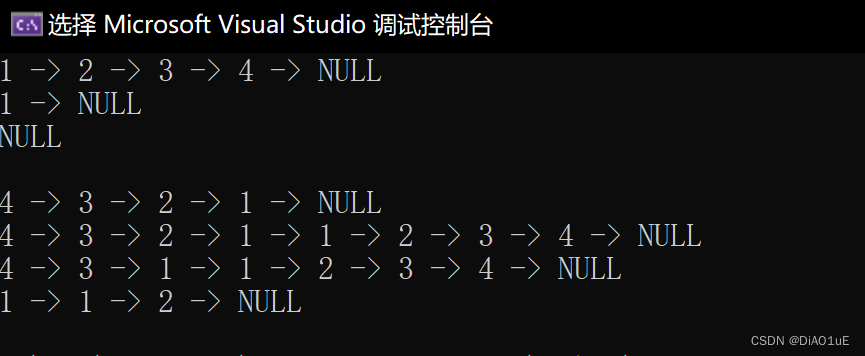文章目录
1 定义
链表是一种物理存储结构上非连续、非顺序的存储结构,数据元素的逻辑顺序是通过链表中的指针链接次序实现的。 链表解决了顺序表带来的弊端。
特点:按需向堆申请内存,不用了就释放空间
优点:增删数据不需要挪动数据;不存在空间浪费
缺点:每存一个数据都要存一个指针去链接后面的数据节点;不支持随机访问
2 分类
2.1 单向或双向

2.2 带头或不带头

2.3 循环或非循环

原理:
phead头节点是一个指针,存的是链表第一个值的地址,
3 实现
3.1 不带头单向不循环链表SList
每个节点的结构体包括一个值和一个指向下一个节点的指针
3.1.1 代码实现
// SList.h
#pragma once
#include<stdio.h>
#include <stdlib.h>
#include <assert.h>
typedef int SLTDataType;
typedef struct SListNode
{
SLTDataType data;
struct SListNode* next;
}SLTNode;
// 打印
void SListPrint(SLTNode* phead);
// 创建结点
SLTNode* BuyListNode(SLTDataType x);
// 尾插
void SListPushBack(SLTNode** phead, SLTDataType x);
// 头插
void SListPushFront(SLTNode** phead, SLTDataType x);
// 尾删
void SListPopBack(SLTNode** pphead);
//头删
void SListPopFront(SLTNode** pphead);
// 查找
SLTNode* SListFind(SLTNode* phead, SLTDataType x);
// 任意位置插入
// 在pos之前插入一个结点
void SListInsert(SLTNode** pphead, SLTNode* pos, SLTDataType x);
// 在pos之后插入
void SListInsertAfter(SLTNode** pphead, SLTNode* pos, SLTDataType x);
// 任意位置删除
// 删除当前位置pos
void SListErase(SLTNode** pphead, SLTNode* pos);
// 删除pos之后的
void SListEraseAfter(SLTNode** pphead, SLTNode* pos);
// 销毁
void SListDestroy(SLTNode** pphead);
// SList.c
#define _CRT_SECURE_NO_WARNINGS 1
#include "SList.h"
//typedef struct SListNode
//{
// SLTDataType data;
// struct SListNode* next;
//}SLTNode;
// 创建节点
SLTNode* BuyListNode(SLTDataType x) {
SLTNode* newnode = (SLTNode*)malloc(sizeof(SLTNode));
if (newnode == NULL) {
exit(-1);
}
newnode->data = x;
newnode->next = NULL;
return newnode;
}
//打印
void SListPrint(SLTNode* phead) {
SLTNode* cur = phead;
while (cur != NULL) {
printf("%d->", cur->data);
cur = cur->next;
}
printf("NULL\n");
}
//尾插
void SListPushBack(SLTNode** phead, SLTDataType x) {
/*SLTNode* newnode = (SLTNode*)malloc(sizeof(SLTNode));
if (newnode == NULL) {
exit(-1);
}
newnode->data = x;
newnode->next = NULL;*/
SLTNode* newnode = BuyListNode(x);
if (*phead == NULL) {
*phead = newnode;
}
else {
SLTNode* tail = *phead;
while (tail->next != NULL) {
tail = tail->next;
}
tail->next = newnode;
}
}
// 头插
void SListPushFront(SLTNode** phead, SLTDataType x) {
SLTNode* newnode = BuyListNode(x);
newnode->next = *phead;
*phead = newnode;
}
// 尾删
void SListPopBack(SLTNode** pphead) {
assert(*pphead != NULL);
if ((*pphead)->next == NULL) {
free(*pphead);
*pphead = NULL;
}
else {
SLTNode* tail = *pphead;
while (tail->next->next) {
tail = tail->next;
}
free(tail->next);
tail->next = NULL;
}
}
//头删
void SListPopFront(SLTNode** pphead) {
if (*pphead == NULL) {
return;
}
SLTNode* next = (*pphead)->next;
free(*pphead);
*pphead = next;
}
// 查找
SLTNode* SListFind(SLTNode* phead, SLTDataType x) {
SLTNode* cur = phead;
while (cur) {
if (cur->data == x) {
return cur;
}
else {
cur = cur->next;
}
}
return NULL;
/*while (cur) {
if (cur->data == x) {
break;
}
cur = cur->next;
}
if (cur != NULL) {
return cur;
}
else {
printf("没找到\t");
return NULL;
}*/
}
// 任意位置插入
// 在pos之前插入一个结点
void SListInsert(SLTNode** pphead, SLTNode* pos, SLTDataType x) {
// 头节点,相当于头插
if (pos == *pphead) {
SListPushFront(pphead, x);
}
else {
// 找到pos的前一个位置prev
SLTNode* newnode = BuyListNode(x);
SLTNode* prev = *pphead; //
while (prev->next) {
if (prev->next == pos) {
break;
}
prev = prev->next;
}
prev->next = newnode;
newnode->next = pos;
}
}
// 在pos之后插入
void SListInsertAfter(SLTNode** pphead, SLTNode* pos, SLTDataType x) {
assert(pos);
SLTNode* newnode = BuyListNode(x);
newnode->next = pos->next;
pos->next = newnode;
}
// 任意位置删除
// 删除当前位置pos
void SListErase(SLTNode** pphead, SLTNode* pos) {
assert(pos);
assert(*pphead);
// pos是头节点
if (*pphead == pos) {
/*if (pos->next == NULL) {
*pphead = NULL;
}
else {*/
// 如果只有一个节点pos那pos->next本来也是null,不用分类
*pphead = pos->next;
free(pos);
//}
}
else {
SLTNode* prev = *pphead;
// pos的前一个
while (prev->next != pos) {
prev = prev->next;
}
// pos = pos->next;
prev->next = pos->next;
free(pos);
}
}
// 删除pos之后的值
void SListEraseAfter(SLTNode** pphead, SLTNode* pos)
{
assert(pos);
SLTNode* next = pos->next;
pos->next = next->next;
free(next);
}
// 销毁
所有节点都要释放,避免内存泄漏
//void SListDestroy(SLTNode** pphead) {
// free(*pphead);
// *pphead = NULL;
//}
void SListDestroy(SLTNode** pphead) {
SLTNode* cur = *pphead;
while (cur) {
SLTNode* next = cur->next;
free(cur);
cur = next;
}
*pphead = NULL;// plist置空
}
// 测试用例
// Test.c
#define _CRT_SECURE_NO_WARNINGS 1
#include "SList.h"
void TestSList1()
{
printf("TEST1:\n");
SLTNode* plist = NULL;// 初始化
SListPushBack(&plist, 1);
SListPushBack(&plist, 2);
SListPushBack(&plist, 3);
SListPushBack(&plist, 4);
SListPushFront(&plist, 2);
SListPushFront(&plist, 7);
SListPushFront(&plist, 6);
SListPrint(plist);
// 6 7 2 1 2 3 4
SListPopBack(&plist);
SListPopFront(&plist);
SListPopFront(&plist);
SListPopFront(&plist);
// 1 2 3
//SListPopFront(&plist);
SListPrint(plist);
printf("TEST1 END\n");
SListDestroy(&plist);
}
void TestSList2()
{
printf("TEST2:\n");
SLTNode* plist = NULL;// 初始化
SListPushBack(&plist, 1);
SListPushBack(&plist, 2);
SListPushBack(&plist, 3);
SListPushBack(&plist, 4);
SListPushFront(&plist, 2);
// 2 1 2 3 4
SListPrint(plist);
SLTNode* pos = SListFind(plist, 1);
SListEraseAfter(&plist, pos);
SListErase(&plist, pos);
// 2 3 4
SListPrint(plist);
pos = SListFind(plist, 2);
SListInsert(&plist, pos, 5);
SListInsertAfter(&plist, pos, 9);
// 5 2 9 3 4
SListPrint(plist);
pos = SListFind(plist, 8);
printf("%p\n", pos);
printf("TEST2 END\n");
SListDestroy(&plist);
}
int main() {
TestSList1();
TestSList2();
return 0;
}
3.1.2 运行结果

3.2 带头双向循环链表List
每个节点的结构体包括一个值,一个指向上一个节点的指针和一个指向下一个节点的指针
3.2.1 代码实现
// List.h
#pragma once
#include <stdio.h>
// 带头+双向+循环链表增删查改实现
typedef int LTDataType;
typedef struct ListNode
{
LTDataType _data;
struct ListNode* _next;
struct ListNode* _prev;
}ListNode;
// 创建返回链表的头结点.
ListNode* ListCreate();
// 双向链表销毁
void ListDestroy(ListNode* pHead);
// 双向链表打印
void ListPrint(ListNode* pHead);
// 双向链表尾插
void ListPushBack(ListNode* pHead, LTDataType x);
// 双向链表尾删
void ListPopBack(ListNode* pHead);
// 双向链表头插
void ListPushFront(ListNode* pHead, LTDataType x);
// 双向链表头删
void ListPopFront(ListNode* pHead);
// 双向链表查找
ListNode* ListFind(ListNode* pHead, LTDataType x);
// 双向链表在pos的前面进行插入
void ListInsert(ListNode* pos, LTDataType x);
// 双向链表删除pos位置的节点
void ListErase(ListNode* pos);
// List.c
#include "List.h"
#include <assert.h>
#include <stdlib.h>
//typedef struct ListNode
//{
// LTDataType _data;
// struct ListNode* _next;
// struct ListNode* _prev;
//}ListNode;
// 创建返回链表的头结点.
ListNode* ListCreate() {
ListNode* pHead = (ListNode*)malloc(sizeof(ListNode));
if (pHead) {
pHead->_next = pHead;
pHead->_prev = pHead;
}
return pHead;
}
// 双向链表销毁
void ListDestroy(ListNode* pHead) {
assert(pHead);
ListNode* tail = pHead->_prev;
while (tail != pHead) {
ListNode* prev = tail->_prev;
free(tail);
tail = prev;
}
free(pHead);
}
ListNode* BuyListNode(LTDataType x) {
ListNode* newNode = (ListNode*)malloc(sizeof(ListNode));
if (newNode) {
newNode->_data = x;
newNode->_next = NULL;
newNode->_prev = NULL;
}
return newNode;
}
// 双向链表打印
void ListPrint(ListNode* pHead) {
ListNode* cur = pHead->_next;
while (cur != pHead) {
printf("%d -> ", cur->_data);
cur = cur->_next;
}
printf("NULL\n");
}
// 双向链表尾插
void ListPushBack(ListNode* pHead, LTDataType x) {
/*ListNode* newNode = (ListNode*)malloc(sizeof(ListNode));
newNode->_data = x;*/
ListNode* newNode = BuyListNode(x);
ListNode* tail = pHead->_prev;
tail->_next = newNode;
newNode->_prev = tail;
newNode->_next = pHead;
pHead->_prev = newNode;
}
// 双向链表尾删
void ListPopBack(ListNode* pHead) {
assert(pHead);
assert(pHead->_next != pHead);
ListNode* tail = pHead->_prev;
ListNode* prev = tail->_prev;
prev->_next = pHead;
pHead->_prev = prev;
free(tail);
}
// 双向链表头插
void ListPushFront(ListNode* pHead, LTDataType x) {
/*ListNode* newNode = (ListNode*)malloc(sizeof(ListNode));
newNode->_data = x;*/
ListNode* newNode = BuyListNode(x);
ListNode* head = pHead;
ListNode* next = head->_next;
newNode->_next = next;
next->_prev = newNode;
head->_next = newNode;
newNode->_prev = head;
}
// 双向链表头删
void ListPopFront(ListNode* pHead) {
assert(pHead);
// 避免删掉哨兵位
assert(pHead->_next != pHead);
ListNode* head = pHead;
ListNode* cur = head->_next;
ListNode* next = cur->_next;
head->_next = next;
next->_prev = head;
free(cur);
}
// 双向链表查找
ListNode* ListFind(ListNode* pHead, LTDataType x) {
ListNode* cur = pHead->_next;
/*while (cur->_data != x) {
cur = cur->_next;
if (cur == pHead) {
return NULL;
}
}
return cur;*/
while (cur != pHead) {
if (cur->_data == x) {
return cur;
}
cur = cur->_next;
}
return NULL;
}
// 双向链表在pos的前面进行插入
void ListInsert(ListNode* pos, LTDataType x) {
assert(pos);
/*ListNode* newNode = (ListNode*)malloc(sizeof(ListNode));
newNode->_data = x;*/
ListNode* newNode = BuyListNode(x);
ListNode* prev = pos->_prev;
newNode->_next = pos;
prev->_next = newNode;
pos->_prev = newNode;
newNode->_prev = prev;
}
// 双向链表删除pos位置的节点
void ListErase(ListNode* pos) {
assert(pos);
ListNode* prev = pos->_prev;
ListNode* next = pos->_next;
prev->_next = next;
next->_prev = prev;
free(pos);
}
// Test.c
// 测试用例
#include "List.h"
void TestList1()
{
ListNode* plist = ListCreate();
ListPushBack(plist, 1);
ListPushBack(plist, 2);
ListPushBack(plist, 3);
ListPushBack(plist, 4);
// 4 3 2 1
ListPrint(plist);
ListPopBack(plist);
ListPopBack(plist);
ListPopBack(plist);
ListPrint(plist);
ListPopBack(plist);
//ListPopBack(plist);
ListPrint(plist);
}
void TestList2()
{
ListNode* plist = ListCreate();
ListPushFront(plist, 1);
ListPushFront(plist, 2);
ListPushFront(plist, 3);
ListPushFront(plist, 4);
// 4 3 2 1
ListPrint(plist);
ListPushBack(plist, 1);
ListPushBack(plist, 2);
ListPushBack(plist, 3);
ListPushBack(plist, 4);
// 4 3 2 1 1 2 3 4
ListPrint(plist);
ListNode* pos = ListFind(plist, 2);
if (pos)
{
ListErase(pos);
}
// 4 3 1 1 2 3 4
ListPrint(plist);
ListPopBack(plist);
ListPopBack(plist);
ListPopFront(plist);
ListPopFront(plist);
// 1 1 2
ListPrint(plist);
ListDestroy(plist);
plist = NULL;
}
int main()
{
TestList1();
printf("\n");
TestList2();
return 0;
}
3.2.2 运行结果

4 顺序表vs链表
4.1 区别(优/缺点):
4.1.1 顺序表:
优点:
1.支持随机访问;
2.CPU高速缓存命中率高;
缺点:
1.插入删除头部和中间元素的时间复杂度为O(n),效率低;
2.为避免频繁开辟内存空间,会以倍数形式开辟空间,与此同时会带来空间浪费的问题。
4.1.2 链表(带头双向循环)
优点:
1.效率高,任意位置插入删除元素的时间复杂度都为O(1);
2.按需申请和释放空间,没有空间浪费;
缺点:
1.不支持随机访问,从而导致一些算法不适用, 比如二分查找,部分排序等;
2.每添加一个值都会附带存储链接指针,也会占用一定的资源(不过可忽略);
3.CPU高速缓存命中率低。